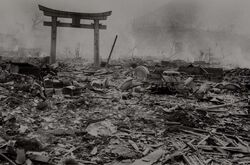| Torii from Nagasaki | |
|---|---|

| |
|
Origin |
The Atomic Bombing of Nagasaki |
|
Type |
Torii |
|
Effects |
Absorbs radiation and converts it into light |
|
Downsides |
None Identified |
|
Activation |
Presence of radiation |
|
Collected by |
Warehouse 13 |
|
Section |
|
|
Aisle |
N/A |
|
Date of Collection |
February 3, 1946 |
| [Source] | |
Origin[]
A torii is a traditional Japanese gate most commonly found at the entrance of or within a Shinto shrine, where it symbolically marks the transition from the profane to the sacred.
Nagasaki is the capital and the largest city of Nagasaki Prefecture on the island of Kyushu in Japan. It became a center of Portuguese and other European influence in the 16th through 19th centuries, and the Churches and Christian Sites in Nagasaki have been proposed for inscription on the UNESCO World Heritage List. Part of Nagasaki was home to a major Imperial Japanese Navy base during the First Sino-Japanese War and Russo-Japanese War. Its name means "long cape".
In August 1945, during the final stage of the Second World War, the United States dropped atomic bombs on the Japanese cities of Hiroshima and Nagasaki. The two bombings, which killed at least 129,000 people, remain the only use of nuclear weapons for warfare in history.
Effect[]
This torii was used to mark the entrance of a Shinto shrine in Nagasaki, Japan. It survived the atomic bombing of 1945, and was later recovered by Warehouse Agents. The gate absorbs all radiation in a 100 foot radius, and converts it into light. It is used in the Radiation Section to keep the radiation levels at a safe level.
